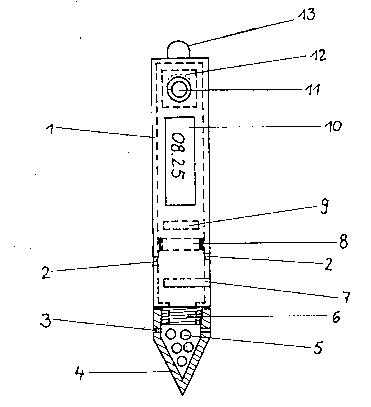Some of the information on this Web page has been provided by external sources. The Government of Canada is not responsible for the accuracy, reliability or currency of the information supplied by external sources. Users wishing to rely upon this information should consult directly with the source of the information. Content provided by external sources is not subject to official languages, privacy and accessibility requirements.
Any discrepancies in the text and image of the Claims and Abstract are due to differing posting times. Text of the Claims and Abstract are posted:
| (12) Patent Application: | (11) CA 2190484 |
|---|---|
| (54) English Title: | WATER DEPTH GAUGE |
| (54) French Title: | INDICATEUR DE PROFONDEUR D'EAU |
| Status: | Deemed Abandoned and Beyond the Period of Reinstatement - Pending Response to Notice of Disregarded Communication |
| (51) International Patent Classification (IPC): |
|
|---|---|
| (72) Inventors : |
|
| (73) Owners : |
|
| (71) Applicants : |
|
| (74) Agent: | SMART & BIGGAR LP |
| (74) Associate agent: | |
| (45) Issued: | |
| (86) PCT Filing Date: | 1995-04-01 |
| (87) Open to Public Inspection: | 1995-11-02 |
| Availability of licence: | N/A |
| Dedicated to the Public: | N/A |
| (25) Language of filing: | English |
| Patent Cooperation Treaty (PCT): | Yes |
|---|---|
| (86) PCT Filing Number: | PCT/DE1995/000450 |
| (87) International Publication Number: | WO 1995029382 |
| (85) National Entry: | 1996-11-15 |
| (30) Application Priority Data: | |||||||||
|---|---|---|---|---|---|---|---|---|---|
|
The invention relates to a depth gauge for use in
angling or sports fishery. The depth of a body of water
may be measured therewith from its surface to its bottom,
and/or the depth and the size of strata of water of
different temperatures for the purpose of offering bait
to different species of fish in their preferred
environments, for instance at the bottom of a water or at
a thermocline stratum.
In accordance with the invention, a water-proof
housing a temperature sensor, a pressure sensor, a
digital evaluation circuit, a display and a program
switch are provided within a water-proof housing and
electrically interconnected in such a manner, that the
measurement value about the depth of the water to its
bottom and/or water strata marked by temperature
differences of more than 3° Kelvin are processed and
stored by the digital evaluation circuit. By means of
the program switch, the stored measurement data may be
called up and rendered visible in the display. In its
construction and configuration the depth gauge is
optimally suited for its intended use. It is light and
small, and it may be industrially manufactured with
little investment.
L'invention concerne un indicateur de profondeur d'eau s'utilisant dans la pêche à la ligne et la pêche sportive. Il permet de mesurer la profondeur de l'eau, de la surface de l'eau jusqu'au fond, et/ou l'épaisseur de couches d'eau présentant différentes températures, à l'intérieur des eaux, afin de pouvoir donner en pâture aux différentes variétés de poissons un appât leur correspondant, dans leurs zones de prédilection, par ex. au fond de l'eau ou dans des couches où la température varie. Selon l'invention, un boîtier étanche à l'eau comprend un détecteur de température, un détecteur de pression, un circuit d'évaluation numérique, un système d'affichage et un combinateur séquentiel agencés dans un boîtier étanche à l'eau, qui sont interconnectés de manière à ce que des valeurs mesurées sur des profondeurs allant jusqu'aux fonds subaquatiques et/ou des valeurs mesurées sur des couches d'eau caractérisées par des différences de températures supérieures à 3 Kelvin puissent être traitées et mémorisées par le circuit d'évaluation numérique. Un combinateur séquentiel permet d'appeler les données mesurées mémorisées et de les afficher. De par sa structure et sa forme, l'indicateur de profondeur d'eau convient optimalement à l'utilisation qui lui est dévolue. Petit et léger, il peut être produit de manière industrielle sans impliquer une grande complexité technique.
Note: Claims are shown in the official language in which they were submitted.
Note: Descriptions are shown in the official language in which they were submitted.

2024-08-01:As part of the Next Generation Patents (NGP) transition, the Canadian Patents Database (CPD) now contains a more detailed Event History, which replicates the Event Log of our new back-office solution.
Please note that "Inactive:" events refers to events no longer in use in our new back-office solution.
For a clearer understanding of the status of the application/patent presented on this page, the site Disclaimer , as well as the definitions for Patent , Event History , Maintenance Fee and Payment History should be consulted.
| Description | Date |
|---|---|
| Inactive: IPC from MCD | 2006-03-12 |
| Time Limit for Reversal Expired | 2001-04-02 |
| Application Not Reinstated by Deadline | 2001-04-02 |
| Deemed Abandoned - Failure to Respond to Maintenance Fee Notice | 2000-04-03 |
| Application Published (Open to Public Inspection) | 1995-11-02 |
| Abandonment Date | Reason | Reinstatement Date |
|---|---|---|
| 2000-04-03 |
The last payment was received on 1999-03-01
Note : If the full payment has not been received on or before the date indicated, a further fee may be required which may be one of the following
Please refer to the CIPO Patent Fees web page to see all current fee amounts.
| Fee Type | Anniversary Year | Due Date | Paid Date |
|---|---|---|---|
| MF (application, 3rd anniv.) - small | 03 | 1998-04-01 | 1998-04-01 |
| MF (application, 4th anniv.) - small | 04 | 1999-04-01 | 1999-03-01 |
Note: Records showing the ownership history in alphabetical order.
| Current Owners on Record |
|---|
| BERND STERNAL |
| Past Owners on Record |
|---|
| None |